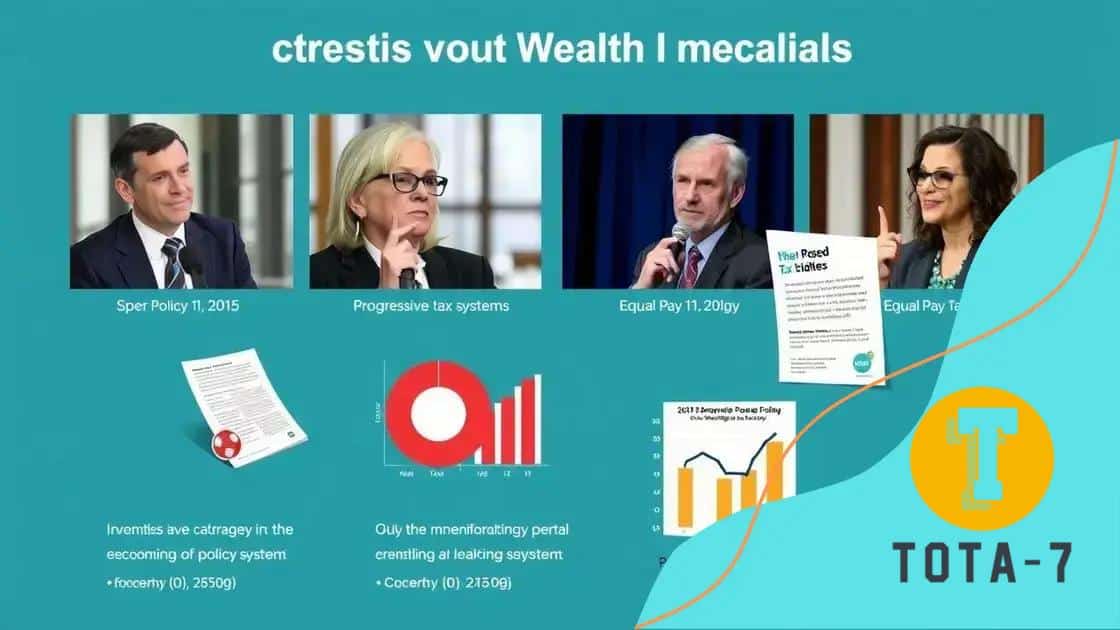Gender wealth gap prompts policy discussions on equality

The gender wealth gap results from disparities in income, access to education, and societal barriers, necessitating targeted policies and educational initiatives to ensure equal opportunities for women in wealth accumulation.
Gender wealth gap prompts policy discussions that challenge us to rethink financial equity. Have you ever considered how wealth distribution affects opportunities for everyone? Let’s delve deeper into this complex issue.
Understanding the gender wealth gap
Understanding the gender wealth gap is crucial to addressing financial inequality. This gap refers to the difference in wealth between men and women. It highlights how systemic issues and societal norms affect women’s ability to accumulate and retain wealth. Why is this important? Because wealth impacts access to opportunities and resources that enable personal and professional growth.
What Causes the Gender Wealth Gap?
Several factors contribute to the widening of the wealth gap between genders. Firstly, income disparities play a significant role. Women, on average, earn less than men for similar work, leading to lower overall wealth accumulation over time. Additionally, caregiving responsibilities often fall to women, limiting their career advancement and income potential.
Societal Impacts
This gap does not only affect individual women but also has broader societal implications. When women have less wealth, they have less influence on financial decisions, business ownership, and community investments. This can perpetuate a cycle of inequality that impacts future generations.
Key Points to Consider
- Wealth accumulation is affected by education levels and access to high-paying jobs.
- Traditional gender roles can restrict women’s participation in the workforce.
- Barriers such as discrimination and unequal policies contribute to the disparity.
Understanding the gender wealth gap requires us to look at these interconnected factors critically. By addressing the root causes, we can work towards more equitable solutions that empower all individuals.
Historical context and current statistics

The historical context of the gender wealth gap reveals deep-rooted inequalities that have evolved over time. Traditionally, women faced numerous barriers, including limited access to education and job opportunities. These restrictions created a lasting impact on women’s financial independence. Understanding these historical factors is essential for grasping the present-day statistics.
Historical Factors Influencing Wealth
Throughout history, women have had fewer rights regarding property ownership and financial decisions. This inequity resulted from societal norms that favored men in economic roles. As the years progressed, gradual changes in laws allowed women to own property and manage finances. Despite these advancements, the pace was slow, leading to slower wealth accumulation.
Current Statistics on Wealth Disparity
Today, the statistics highlight ongoing disparities. Research shows that women, on average, earn about 82 cents for every dollar a man makes. This pay gap not only reflects income differences but also contributes to the wealth gap, as lower earnings lead to fewer savings and investments. Furthermore, data indicates that women hold significantly less wealth than men, with studies showing that single women have about 32% less wealth than their male counterparts.
- In family structures, single mothers are particularly affected, often struggling to balance work and childcare.
- Investments are another area of concern; women tend to invest less than men, which can hinder wealth growth.
- Intersectionality plays a role; women of color often experience greater disparities in wealth than white women.
Recognizing both the historical context and current statistics is vital in understanding the gender wealth gap. Addressing these issues requires a keen awareness of how far we’ve come and the challenges that remain.
Impact of the gender wealth gap on society
The impact of the gender wealth gap on society is significant and wide-reaching. When women are not able to accumulate wealth like men, it affects not only their personal lives but also the economic structure of communities and nations. This gap enforces systems of inequality that can hinder social progress.
Economic Consequences
A smaller wealth base for women means less spending power within households. When women earn less, it restricts their ability to invest in education, healthcare, and housing, which are essential for long-term growth. This can lead to a cycle where future generations also face similar challenges. To put it simply, communities with a significant gender wealth gap often struggle with higher poverty rates.
Social Dynamics
The gender wealth gap also influences social dynamics. As women gain more wealth, they contribute more significantly to public services and charitable organizations. However, when wealth is concentrated among men, women’s voices and needs may be overlooked. This limitation can lead to policies that do not reflect the interests of half the population.
- Women are often more likely to invest in their families and communities.
- Wealthier women can influence decision-making in a more equitable way.
- The gap can perpetuate stereotypes about women’s roles, affecting their social standing.
The societal effects of the gender wealth gap call for urgent attention and action. To create a balanced approach to wealth distribution, it is vital to understand how these dynamics impact everyone.
Policies to address wealth inequality

Policies to address wealth inequality are essential for creating a more equitable society. These policies can help bridge the gap between genders and ensure that everyone has the opportunity to thrive financially. Governments and organizations must consider a variety of approaches to tackle this pressing issue.
Progressive Taxation
One effective policy is progressive taxation. This system taxes individuals based on their income levels, ensuring that those who earn more pay a higher tax rate. The revenue generated can be reinvested into education, healthcare, and social services, benefiting lower-income groups.
Equal Pay Legislation
Implementing equal pay legislation is also crucial. Laws that enforce equal pay for equal work can help narrow the wage gap between men and women. These measures encourage transparency in salary reporting and promote accountability among employers.
- Regular audits can ensure compliance with pay equity standards.
- Training programs can be implemented to educate employers about fair compensation practices.
- Promotion of women in leadership roles can be encouraged through targeted initiatives.
Another effective approach is providing access to affordable education and training programs. This helps empower women and marginalized groups, giving them the skills necessary to enter or advance in high-paying industries. Community programs that offer financial literacy training can also make a significant difference.
To build a robust system that tackles wealth inequality, policies should focus on both the root causes and practical solutions. Collaboration between governments, private sectors, and communities is essential to make lasting changes that benefit everyone.
The role of education in closing the gap
The role of education in closing the gender wealth gap is fundamental. Education empowers individuals, equipping them with the skills needed to succeed in the workforce. For many women, gaining access to quality education can unlock doors to better job opportunities and higher salaries.
Access to Quality Education
Providing equal access to quality education is essential for leveling the playing field. Schools and programs that support girls encourage them to pursue subjects like science, technology, engineering, and math (STEM). Encouraging female participation in these fields can lead to higher-paying jobs and career advancements.
Career Development and Training
Beyond basic education, continuous learning and career development opportunities are crucial. Programs that offer vocational training help women gain specific skills that align with market demands. Community colleges and technical schools play a significant role in providing such training.
- Mentorship programs can pair women with experienced professionals.
- Scholarships targeted at women can make higher education more accessible.
- Workshops focused on financial literacy can enhance money management skills.
Moreover, educational initiatives that focus on empowering women not only benefit individuals but also strengthen communities. When women are educated and financially independent, they are more likely to invest in their families and neighborhoods. This positive ripple effect is vital for breaking the cycle of poverty.
<pUltimately, addressing the gender wealth gap through education is not just an investment in women, but an investment in the future of society. Enhanced education opportunities can lead to a stronger economy and healthier communities for all.
As we reflect on the many dimensions of the gender wealth gap, it’s clear that significant challenges remain. Education, policy changes, and societal support play crucial roles in closing this gap.
By focusing on empowering women through access to education and equitable policies, we can create a more balanced society. It’s essential to remember that investing in women’s education and financial independence not only benefits individuals but also uplifts entire communities.
Together, we can take actionable steps towards a future where wealth is shared more equally, leading to stronger families and healthier communities for all.
FAQ – Frequently Asked Questions about the Gender Wealth Gap
What is the gender wealth gap?
The gender wealth gap refers to the disparity in wealth accumulation between men and women, often resulting from factors such as unequal pay, access to education, and societal norms.
How can education impact the gender wealth gap?
Education empowers women by providing essential skills and knowledge, which can lead to better job opportunities and higher salaries, helping to close the wealth gap.
What policies can help reduce wealth inequality?
Policies like progressive taxation and equal pay legislation can help ensure that everyone has a fair chance at accumulating wealth, benefiting society as a whole.
Why is addressing the gender wealth gap important for society?
Closing the gender wealth gap leads to economic growth, improves family and community wellbeing, and promotes fairness and equality within society.





